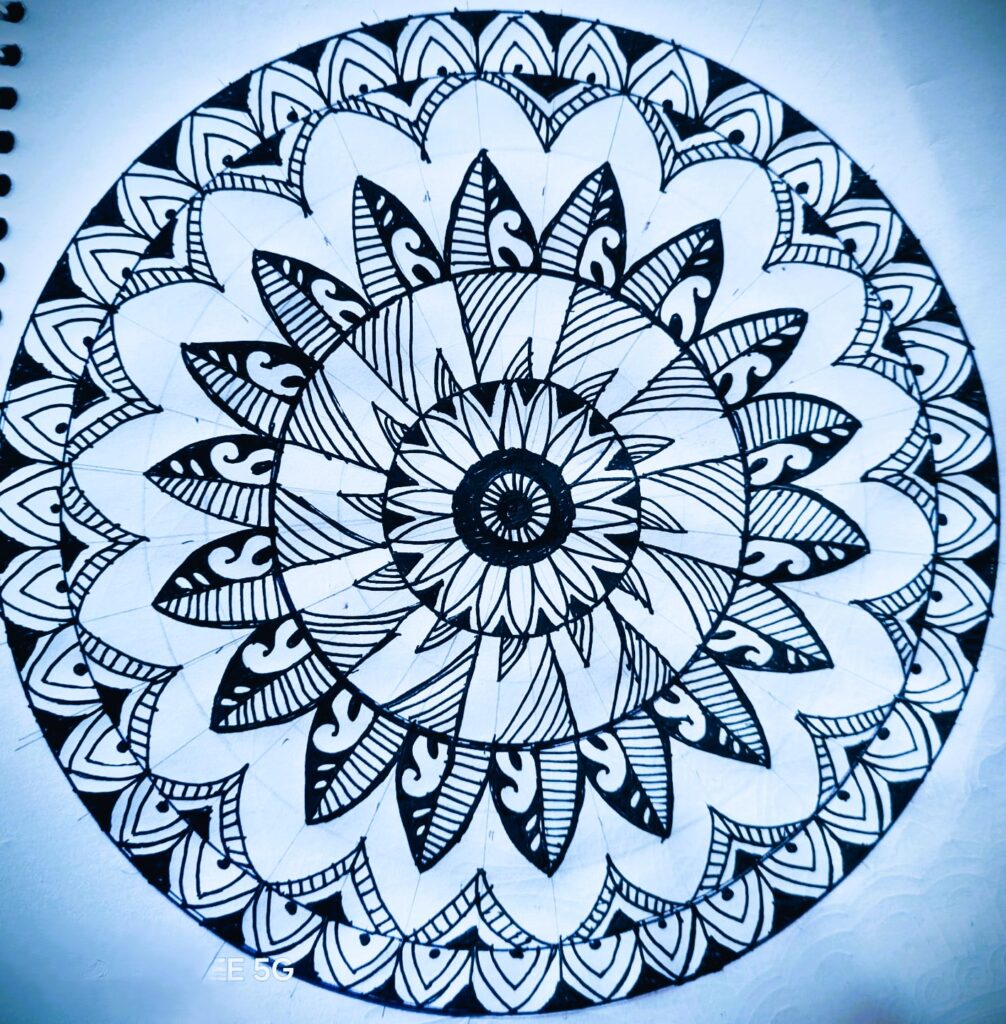Yes, mandalas can be one of the most effective healing therapies, depending on the individual’s needs and preferences. The act of creating, coloring, or meditating with mandalas offers various psychological, emotional, and spiritual benefits, making it a powerful tool for personal growth and healing.
Basically mandala is a geometric design that holds symbolic and spiritual significance in many cultures. The term “mandala” comes from the Sanskrit word meaning “circle” or “center.” Mandalas are often intricate patterns that radiate from a central point, representing wholeness, balance, and the universe.

Table of Contents
Origins and Cultural Significance
- Hinduism and Buddhism:
- Mandalas are used as spiritual tools, often as aids for meditation.
- They symbolize the universe and the interconnectedness of all things.
- In Buddhism, mandalas are often visual representations of spiritual realms or the journey toward enlightenment.
- Other Cultures:
- Similar designs appear in Native American sand paintings, Celtic knots, and Gothic rose windows, demonstrating the universal appeal of circular patterns.
Key Features of a Mandala
- Central Point:
- The center represents the starting point, self, or divine essence.
- Symmetry and Balance:
- The design radiates outward in balanced patterns, symbolizing harmony and order.
- Repetitive Patterns:
- Repeated shapes, colors, and symbols create a meditative quality.
In modern contexts, mandalas are used as a form of healing therapy, offering psychological, emotional, and spiritual benefits. Here’s how mandalas serve as a therapeutic tool:
Promotes Relaxation and Reduces Stress
- Engaging with mandalas induces a state of mindfulness similar to meditation, helping to calm the mind and reduce anxiety.
- The repetitive patterns and focus required to create or color mandalas encourage deep relaxation.
Encourages Emotional Expression
- Mandalas provide a safe and non-verbal medium to express emotions, especially for individuals who may find it difficult to articulate their feelings.
- Through the use of colors, shapes, and patterns, one can explore and process complex emotions.
Enhances Focus and Mindfulness
- The intricate designs demand attention to detail, drawing individuals into the present moment.
- This meditative focus helps clear mental clutter, leading to greater clarity and concentration.
Fosters Self-Discovery and Personal Growth
- Mandalas are often seen as a reflection of the self. The process of creating one can reveal inner thoughts, desires, and challenges.
- They can serve as a tool for exploring one’s subconscious, aiding in self-awareness and personal insight.
Supports Spiritual Healing
- In many spiritual traditions, mandalas are used as symbols of wholeness and interconnectedness, making them a powerful tool for aligning mind, body, and spirit.
- Meditating on a mandala can deepen spiritual practice, fostering a sense of unity and harmony.
Therapeutic for Mental Health
- Mandala art therapy is increasingly used in psychotherapy to help individuals cope with trauma, depression, and other mental health issues.
- It provides a structured yet creative outlet to explore feelings and work toward healing.
Universal and Accessible
- Mandalas are suitable for people of all ages and artistic abilities.
- They require minimal materials, making them a low-cost and easily accessible therapy.
Evidence Supporting Mandala Healing Therapy
- Studies have shown that engaging with mandalas reduces symptoms of anxiety and depression.
- Coloring mandalas has been found to lower heart rates and promote a sense of calm.
Limitations
While mandalas are a highly effective therapeutic tool for many, they may not work for everyone. Individuals dealing with severe mental health challenges may need a combination of therapies, including professional counseling or medical treatment, alongside creative practices like mandala therapy.
Conclusion
Mandalas serve as a powerful and versatile healing therapy, offering a blend of artistic expression, mindfulness, and emotional release. Rooted in ancient spiritual traditions, mandalas are more than just beautiful patterns; they symbolize wholeness, balance, and the interconnectedness of life. Engaging with mandalas—whether by creating, coloring, or meditating on them—encourages relaxation, reduces stress, and fosters a meditative state. This practice helps individuals process emotions, gain clarity, and cultivate inner peace. The repetitive, symmetrical patterns provide structure and focus, allowing the mind to quiet and enter a state of flow, which can be deeply restorative.
In therapeutic settings, mandalas are used to explore subconscious thoughts, express emotions non-verbally, and aid in self-discovery. Studies have shown their effectiveness in reducing anxiety and depression while promoting mindfulness and emotional well-being. Accessible to people of all ages and abilities, mandala therapy requires minimal resources, making it an inclusive and cost-effective healing practice.
While not a substitute for medical or psychological treatment, mandalas complement traditional therapies by addressing mental, emotional, and spiritual needs holistically. For those seeking calm, self-awareness, or emotional healing, mandalas offer a creative and transformative path toward harmony and well-being.
